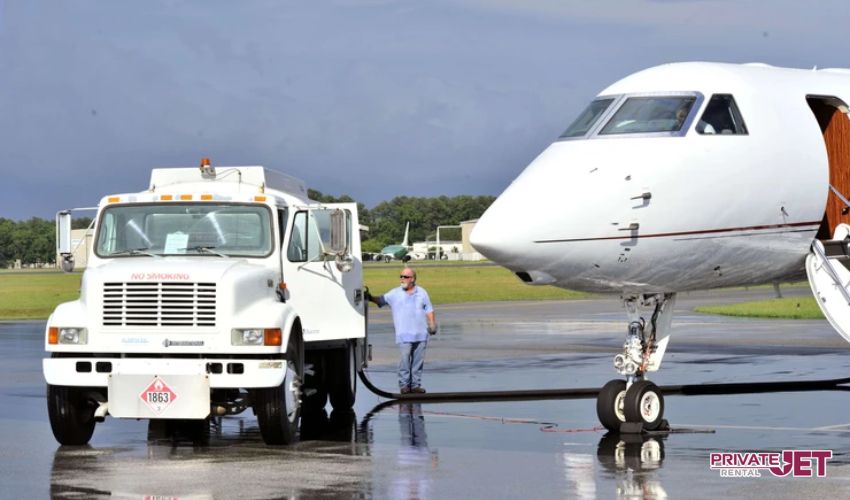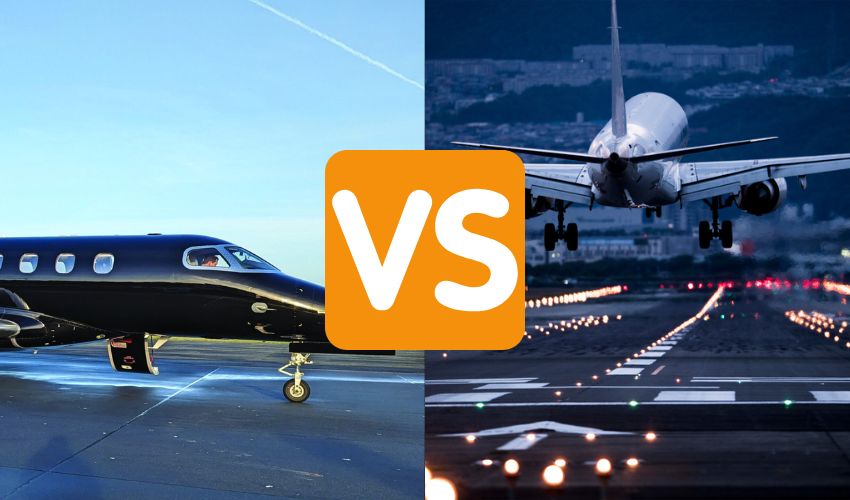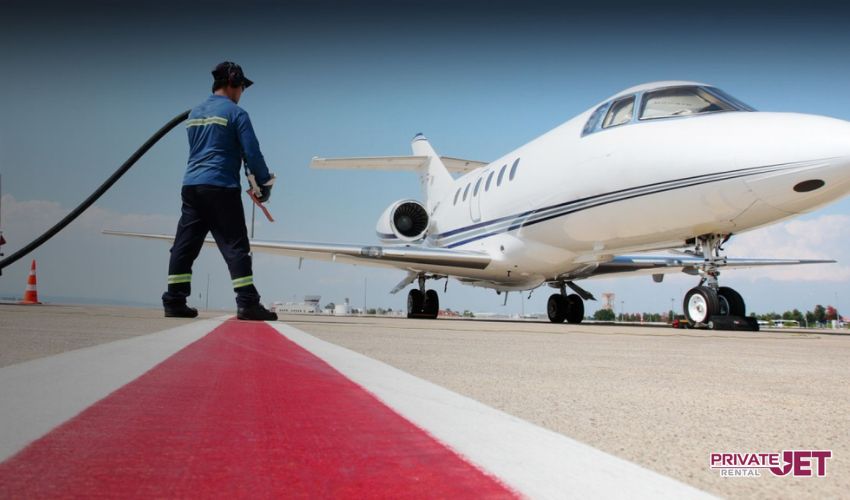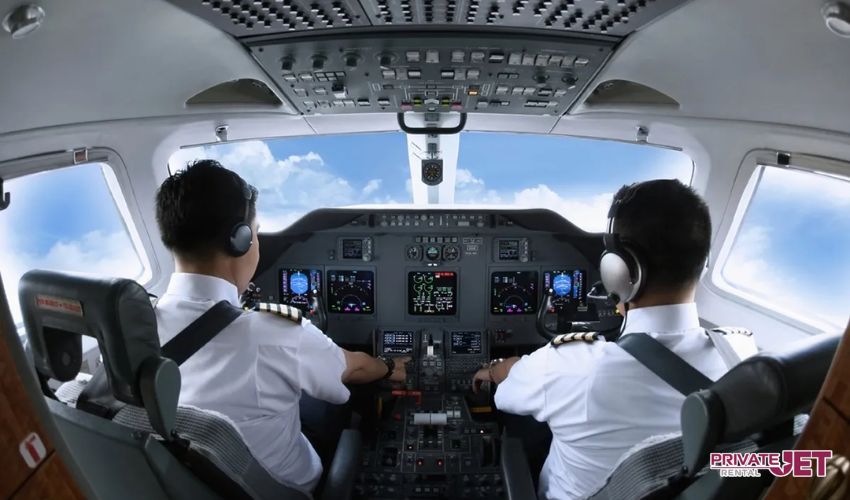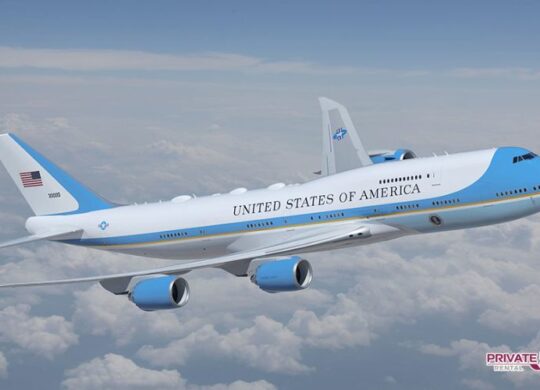Factors Affecting Private Jet Fuel Usage
- Larger and heavier jets burn more fuel.
- Higher speeds and altitudes generally improve fuel efficiency.
- Headwinds and turbulence increase fuel burn.
- Longer flights consume more fuel.
- Takeoff and landing are fuel-intensive.
- Newer engines are more fuel-efficient.
- Passenger and cargo weight as heavier loads increase fuel burn.
Private Jets Vs. Commercial Airlines Fuel Consumption
Private jets, particularly larger private planes, consume more fuel per passenger than commercial airlines. A private jet uses 150 to 600 gallons of fuel per hour, while a commercial airliner uses 2,500 to 5,000 gallons per hour.
However, private jets carry fewer passengers, leading to higher fuel consumption per passenger. For example, a private jet might burn 100 gallons per passenger per hour, whereas a commercial flight might use only 5 gallons per passenger per hour.
Private jets often fly shorter distances and require more frequent refueling stops.
What are Some Fuel-Efficient Private Jets?
| Cirrus SF50 Vision Jet | 5.12 nautical miles per gallon |
| Cessna Citation M2 | 3.8 nautical miles per gallon |
| HondaJet | 3.6 nautical miles per gallon |
| Embraer Phenom 100 | 3.58 nautical miles per gallon |
| Gulfstream G800 | Efficient due to cutting-edge Rolls Royce Pearl 700 engines |
Modern fuel-efficient private jets significantly outperform older models. For example, the Cirrus SF50 Vision Jet and HondaJet achieve around 5.12 and 3.6 nautical miles per gallon, respectively.
In contrast, older jets like the Learjet 35 and Gulfstream II typically manage only 2 to 2.5 nautical miles per gallon. Advances in aerodynamics, materials, and engine technology contribute to these improvements, making newer jets more economical and environmentally friendly.
Several retrofit options can enhance the efficiency of older aircraft. Hybrid propulsion systems combine traditional engines with electric propulsion to reduce fuel consumption and emissions. Engine upgrades involve installing more efficient engines with higher bypass ratios.
Aerodynamic improvements, such as adding winglets, reduce drag. Replacing older components with lightweight materials also helps. Moreover, advanced avionics upgrades improve flight management and fuel efficiency.
Are There Any Efforts to Improve Fuel Efficiency for Private Aviation?
- Advanced Aerodynamics: New designs reduce drag and improve fuel efficiency.
- Lightweight Materials: Using composites and advanced alloys to reduce aircraft weight.
- Efficient Engines: Developing engines that burn less fuel and produce fewer emissions.
- Sustainable Aviation Fuel (SAF): Using biofuels and synthetic fuels to reduce carbon footprint.
- Electric and Hybrid Aircraft: Electric propulsion and hybrid systems for short flights. Electric planes promise a sustainable future.
Efforts to improve fuel efficiency in private aviation involve multiple stakeholders. NASA and the FAA lead initiatives like the Sustainable Flight National Partnership, focusing on advanced aircraft and engine technologies. Aircraft manufacturers such as Boeing and Airbus invest in lightweight materials and efficient designs.
Fuel producers like Neste and Total Energies develop Sustainable Aviation Fuels (SAF). Airlines and private jet operators adopt operational improvements and retrofits.
Are There any Regulations Promoting Eco-Friendly Practices for Private Jets?
Several regulations promote eco-friendly practices for private jets. The Carbon Offsetting and Reduction Scheme for International Aviation (CORSIA) aims to cap and reduce carbon emissions from international flights.
The European Union Emissions Trading System (EU ETS) requires operators to purchase allowances to offset their emissions. In addition, the FAA and EASA enforce stricter emission standards and encourage the use of Sustainable Aviation Fuels (SAF).
How Can Pilots Optimize Fuel Consumption During Flights?
- Step Climb gradually increases altitude as the aircraft burns fuel and becomes lighter, reducing drag and fuel burn.
- Cost Index balances speed and fuel efficiency by adjusting the cost index, which determines the optimal speed for fuel savings.
- Engine Out Taxi uses one engine instead of two during taxiing to save fuel.
- Reduced Thrust Takeoff uses less than maximum thrust during takeoff to save fuel and reduce engine wear.
- Fuel Tankering carries extra fuel from locations where fuel is cheaper, balancing the extra weight against cost savings.
- Wind Optimization adjusts flight paths to take advantage of tailwinds and avoid headwinds, reducing fuel consumption.
- Idle Reverse Thrust uses minimal reverse thrust during landing to save fuel and reduce engine wear.
Final Words About Private Jet Fuel Consumption
Private jet fuel efficiency is very important for sustainability. Modern jets like the Cirrus SF50 and HondaJet are more efficient than older models. Efforts by NASA, FAA, and manufacturers focus on advanced technologies and Sustainable Aviation Fuels.
Pilots optimize fuel use through techniques like step climbs and reduced thrust takeoffs. Regulations like CORSIA and EU ETS promote eco-friendly practices. Retrofit options, such as engine upgrades and aerodynamic improvements, enhance older jets’ efficiency.

